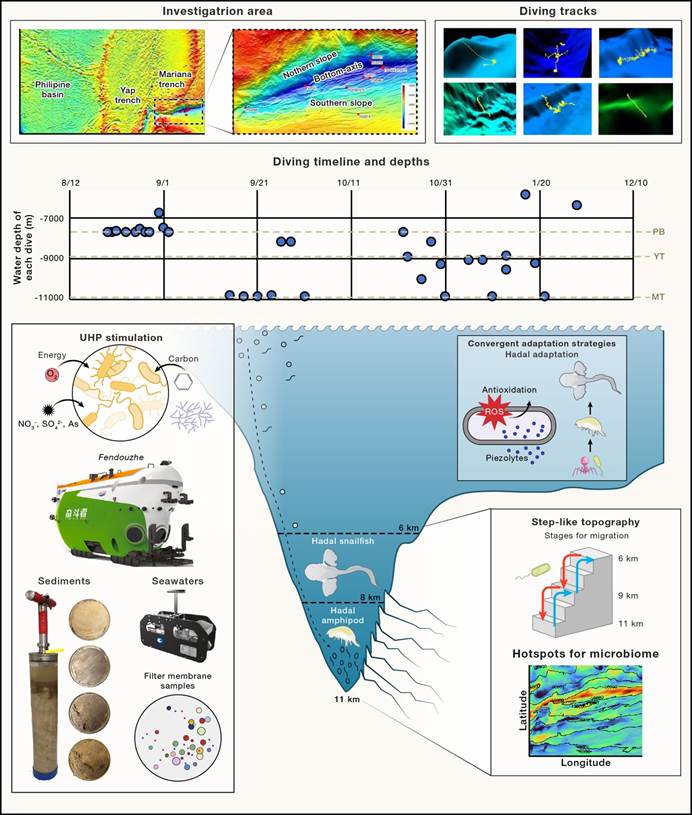搜索


Humans have always been fascinated by the extremes of our world, from the highest mountain to the deepest ocean. Today we are beginning to understand these much more clearly. The latest scientific research at the deepest part of the ocean has revealed something extraordinary - biodiversity is extensive and flourishing despite the extreme conditions.
.png)
On March 6, 2025, Cell published a set of articles - including one commentary and three research papers - reporting the latest findings from the Mariana Trench Environment and Ecology Research (MEER) Project. This collection was featured as a cover story in the latest issue of Cell.
On March 6, Cell featured one commentary and three research articles as a cover story, systematically revealing the ecological characteristics of the hadal zone at water depths exceeding 6,000 meters. These findings mark the latest results from the Mariana Trench Environment and Ecology Research (MEER) Project, a collaboration launched in 2021 by Shanghai Jiao Tong University, BGI Group, the Institute of Deep-Sea Science and Engineering (IDSSE) of the Chinese Academy of Sciences, and other Chinese scientific institutions.
The MEER project: Unveiling the Deepest Ecosystem on Ocean

Information on dives and sampling from the MEER project and its main scientific findings.
The hadal zone, while covering just 1–2% of the ocean floor, accounts for the deepest 45% of the ocean’s vertical depth. It is a realm of extreme conditions, where immense pressure, total darkness, limited food sources, and near-freezing temperatures create an environment that commonly considered inhabitable by only a few specialized organisms.
Using China’s full-ocean-depth-rated manned submersible, Fendouzhe, the research team conducted 33 dives in the Mariana Trench, Yap Trench and Philippine Basin in 2021.
The MEER project, led by Professor Xiang Xiao from Shanghai Jiao Tong University, brought together a multidisciplinary team of scientists during the expedition. Through collaborative discussions and exchanges, they addressed critical bottlenecks in international deep-sea life research from the past decades, establishing the key scientific questions, philosophical framework, and aesthetic logic of the MEER.
The MEER project focused on the ecosystem in the deepest ocean regions, characterizing the features and environmental adaptations of hadal microorganisms, invertebrates (amphipods), and vertebrates (fishes).
Researchers mapped a specialized food chain - from microbes to amphipods to fishes - and discovered unique “Convergent Adaptation” strategies shared between two representative animals and microbes. These adaptations, shaped by the extreme deep-sea environment, transcend species boundaries.
Microbes: Flourishing in the Extreme with Remarkable Adaptations
The MEER team developed an integrated method using latest automation and sequencing technology to analyze environmental samples, leading to the creation of the world’s largest and most comprehensive hadal microbial metagenome dataset.
Their findings uncovered an extraordinary diversity of hadal microorganisms, with over 7,564 newly identified species-level genomes, nearly 90% of which had never been documented in public databases.
To survive at the deepest sea levels on Earth, hadal microorganisms have developed a unique set of evolutionary traits for energy intake and pressure resistance. By analyzing distinct ecological processes and microbial genomic/metabolic traits, scientists have identified two distinct adaptation strategies.



 首页
首页

 学院概况
学院概况

 师资队伍
师资队伍

 人才培养
人才培养

 招生就业
招生就业

 科学研究
科学研究

 平台基地
平台基地

 党群工作
党群工作

 校友之家
校友之家

 安全工作
安全工作

 网上办事
网上办事
 当前位置:
当前位置: